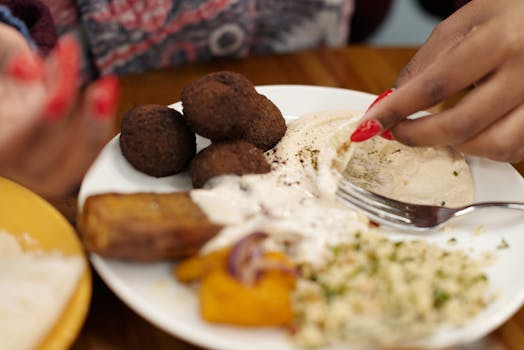Falafel: The Authentic Lebanese Recipe, Crispy and Flavorful Vegetarian Chickpea Meatballs
Falafel, a beloved Middle Eastern dish, has gained immense popularity worldwide as a delicious and nutritious vegetarian option. Originating from the Levant region, particularly Lebanon, falafel is made primarily from chickpeas or fava beans, seasoned with a variety of herbs and spices, and then deep-fried to achieve a crispy exterior. This article delves into the authentic Lebanese recipe for falafel, exploring its history, preparation, and cultural significance.
The Rich History of Falafel
Falafel’s origins are somewhat debated, with various theories suggesting it may have originated in Egypt or the Levant. However, it is widely accepted that the modern version of falafel as we know it today has its roots in Lebanon. The dish has been a staple in Middle Eastern cuisine for centuries, often served as a street food or as part of a larger meal.
Historically, falafel was made with fava beans, but the introduction of chickpeas in the recipe has become more common, especially in Lebanon. The dish is not only a source of sustenance but also a symbol of cultural identity and pride for many Lebanese people.
Ingredients: The Heart of Authentic Falafel
The key to making authentic Lebanese falafel lies in the quality and freshness of the ingredients. Here’s a list of essential components:
- Chickpeas (or fava beans)
- Fresh parsley
- Cilantro
- Onion
- Garlic
- Cumin
- Coriander
- Salt and pepper
- Baking powder
- Flour (optional, for binding)
- Vegetable oil (for frying)
These ingredients come together to create a flavorful mixture that is both nutritious and satisfying. The use of fresh herbs like parsley and cilantro not only enhances the flavor but also adds vibrant color to the dish.
Step-by-Step Preparation of Authentic Lebanese Falafel
Making falafel at home is a rewarding experience. Here’s a simple step-by-step guide to prepare authentic Lebanese falafel:
- Soak the Chickpeas: Begin by soaking dried chickpeas in water for at least 8 hours or overnight. This softens the beans and makes them easier to blend.
- Blend the Ingredients: In a food processor, combine the soaked chickpeas, parsley, cilantro, onion, garlic, cumin, coriander, salt, and pepper. Pulse until the mixture is coarse but well combined.
- Add Baking Powder: Sprinkle in baking powder and mix well. If the mixture feels too loose, add a small amount of flour to help bind it.
- Shape the Falafel: Using your hands or a falafel scoop, form the mixture into small balls or patties.
- Fry the Falafel: Heat vegetable oil in a deep pan. Once hot, carefully add the falafel balls and fry until golden brown and crispy, about 3-4 minutes on each side.
- Drain and Serve: Remove the falafel from the oil and drain on paper towels. Serve hot with tahini sauce, pita bread, and fresh vegetables.
The Cultural Significance of Falafel
Falafel is more than just a dish; it represents a rich cultural heritage. In Lebanon, it is often enjoyed during family gatherings, celebrations, and as a popular street food. The dish has transcended borders, becoming a symbol of Middle Eastern cuisine globally.
Moreover, falafel has gained recognition for its health benefits. It is high in protein, fiber, and essential nutrients, making it an excellent choice for vegetarians and vegans. According to a study published in the Journal of Nutrition, chickpeas can help reduce cholesterol levels and improve heart health.
Conclusion: The Timeless Appeal of Falafel
In conclusion, falafel is a delicious and nutritious dish that embodies the essence of Lebanese cuisine. Its crispy texture and flavorful ingredients make it a favorite among food lovers worldwide. By following the authentic Lebanese recipe, anyone can enjoy this delightful vegetarian treat at home.
Whether served in a wrap, as part of a mezze platter, or on its own with dipping sauces, falafel continues to be a symbol of cultural pride and culinary excellence. As more people seek plant-based options, falafel stands out as a timeless choice that satisfies both the palate and the body.
